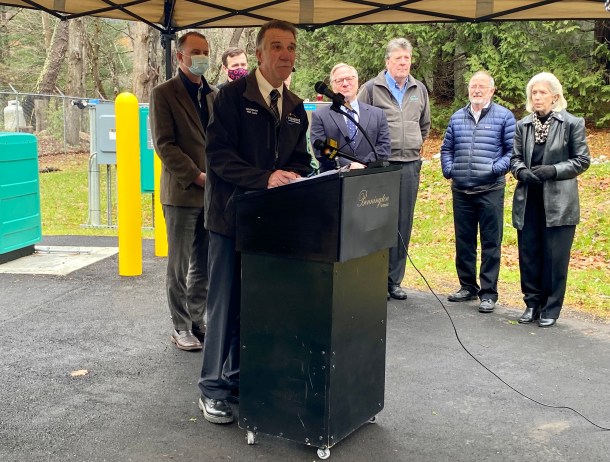
BENNINGTON — In October, the state completed a multiyear, multimillion-dollar project to connect hundreds of homes to the Bennington municipal water system. The homes needed a new source of potable water after their private wells were found to be contaminated with the chemical PFOA.
“It was really scary,” Bennington resident Lora Block said during a state-sponsored news conference Monday to mark the conclusion of the project. She recalled the many questions residents had when the contamination was discovered in 2016, including whether they could still safely consume locally grown vegetables and maple syrup.
Researchers and residents point to a couple of shuttered local factories as the source of the airborne pollutants. The plants in North Bennington and Bennington, which closed in 2002, became famous for fiberglass fabrics used on structures such as sports stadium domes. These products were coated in Teflon, which was manufactured using PFOA, or perfluorooctanoic acid.
Since the discovery of PFOA in the water and soil surrounding the two former ChemFab factories, the state has been working with Saint-Gobain Performance Plastics — the French company that bought ChemFab in 2000 — to figure out how to provide long-term clean drinking water to affected residents.
Under settlement agreements in 2017 and 2019, Saint-Gobain largely funded a project that connected 445 homes in Bennington, North Bennington and Shaftsbury to the Bennington town water system.
Of the $48.7 million total project cost, Saint-Gobain paid $43.7 million, said John Schmeltzer, an environmental analyst with the Vermont Department of Environmental Conservation and co-manager of the project. The state shouldered the rest of the cost.
Until the new water source was in place, Saint-Gobain was required to provide bottled water as well as install and maintain carbon filtering point-of-entry systems to affected households.
The water line work included adding 21 miles of water mains and 15 miles of service lines, according to the state. The project’s first phase, involving homes on the western slope of the contaminated area, was finished in 2019. The final phase, on the eastern slope, ended in early October. Construction work was done by MSK Engineers and Otter Creek Engineering.
“I’m impressed by the magnitude of the project and how quickly it was completed,” Gov. Phil Scott told an audience of around 40 people who gathered outdoors at a Bennington water pumping facility on a chilly and overcast Monday morning.
Attendees included Bennington Selectboard members, Bennington area legislators and state officials such as Attorney General TJ Donovan. Environmental Conservation Commissioner Peter Walke acknowledged the advocacy efforts of the area’s legislative representatives in Montpelier.
But Scott said the corrective work is not over.

“We’ll continue to forge ahead to finish every bit of it,” he said, “and continue to hold Saint-Gobain accountable.”
Not all the residential water wells that showed above-standard levels of PFOA have been diverted to Bennington’s water system. Until a long-term solution for them is found, co-project manager Richard Spiese said about 30 households will continue to use the Saint-Gobain-funded water treatment systems.
The water wells of another 154 homes that tested below standard for PFOA are being monitored to see if the levels change. A consultant for Saint-Gobain conducts sample testing twice a year, the results of which are submitted to the state for review and possible retesting.
The Department of Environmental Conservation has found the PFOA levels in these homes to be “relatively stable,” Schmeltzer said.
Bennington Town Manager Stuart Hurd said Saint-Gobain has been cooperative in this process.
“As a multinational corporation, they could have made this a fight of a lifetime, and they didn’t,” he said at the news conference. “They stepped up.”
When asked for comment about the water line project’s completion, the company said in a statement Monday: “Saint-Gobain is pleased that waterline extensions in the Bennington area are complete and residents have access to municipal water. We have worked closely with the State of Vermont to help fund this project and will continue to work to meet our commitments to the community.”
The news conference came less than a week after Saint-Gobain entered into a $34 million settlement agreement in a class-action suit brought by Bennington-area residents who hold the company responsible for water and soil contamination.

Under the federal case settlement, which is still awaiting court approval, Saint-Gobain agreed to compensate eligible property owners whose wells are contaminated by PFOA. It would also pay to monitor certain diseases among residents exposed to the chemical.
However, the corporation denies any wrongdoing in its former factories’ operations or the presence of PFOA in the area’s drinking water, groundwater and soil.
In her earlier remarks, Block thanked plaintiff attorneys including David Silver, who attended the Monday event, for staying with residents through five years of litigation. “You didn’t drop us, and you kept fighting for us,” she said of the team of four lawyers. “That is very comforting.”
Block also thanked state officials for immediately acknowledging the PFOA water problem.
“I’m really, really grateful that you didn’t hide from us, and you didn’t deny what was happening,” she said.
